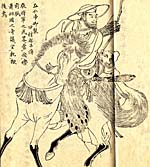
Unit 1: Redefining World Society and Culture
Lesson D: Life and Times in the Pre-Modern World
Activity 5: Japan
Written Activity - Notebook
Examine the image to the right and answer the following questions in your notebook. A reminder, you may not be able to fully answer all of these questions.
- What event does the image portray?
- Who created the image and why?
- What does the image suggest the creator and the civilization valued? What makes you say this?
- Who is in the image, and who is not?
- What conclusions can you draw about the way people lived based upon the image?
You just examined an image of a shogun ruler in Japan. You should have noticed that the shogun appears to be some type of military leader. In actuality, shogun in Japanese society were more powerful than the emperor. The emperor was a figurehead. Various shoguns held the power in Japan and they each had daimyos who were lords. Underneath the daimyos were the samurai warriors.
The relationship between the shoguns, daimyos, and samurai was described in the Code of Bushido. This code outlined proper behavior among the groups. Underneath the samurai were the peasants who did the agricultural work of the country. Peasants were considered more important than artisans and merchants.
Both Shintoism and Buddhism played important roles in Japanese culture; however, leaders of these two religions did not play the same influential role in Japanese politics as did religious leaders in Western Europe. The following image shows the Japanese feudal structure.
Page Notes:
[1] Source: This image from http://commons.wikimedia.org/wiki/File:Sakanoue_Tamuramaro.jpg is in the public domain because its copyright has expired.




